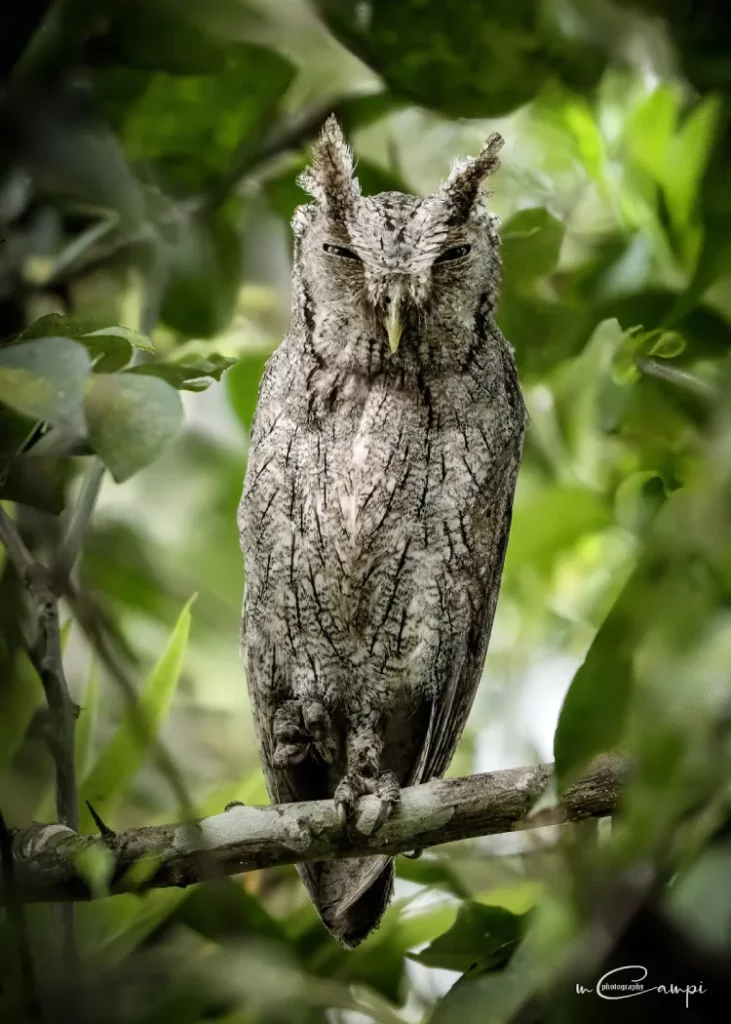Pacific Screech Owl
The Pacific Screech Owl, with its small stature and distinctive trill, is a fascinating species to observe in Costa Rica’s dry forests, offering excellent birdwatching opportunities both day and night.

Megascops cooperi
Scientific Name
Strigidae (Typical Owls)
Family
Strigiformes
Order
Megascops cooperi cooperi (found in southern Mexico to western Costa Rica)
Subspecies.
Megascops cooperi lambi (found in northwestern Costa Rica to Panama)
Subspecies.
Range and Habitat of Pacific Screech Owl
Geographic Range
Found from southern Mexico through Central America, including most of Costa Rica.
Migratory Patterns
Pacific Screech Owl is non-migratory, though it may move locally depending on food availability.
Preferred Habitat
Prefers dry forests, savannas, and open woodlands, but can also be found in more arid regions and urban areas.
Altitude Range
Typically found from sea level up to 1,200 meters (3,900 feet), although it can occasionally be seen at higher altitudes.
Costa Rica Habitat
In Costa Rica, it is commonly found along the Pacific slope, particularly in the dry forests of Guanacaste and Nicoya Peninsula.
Conservation Status
Least Concern
Conservation Status
Population Status
Stable, with no significant declines in its range, and categorized as Least Concern by the IUCN.
Habitat loss due to deforestation, particularly in coastal regions, and urbanization.
Conservation efforts
Protected in Costa Rica’s national parks and reserves, particularly in dry forest regions like Guanacaste National Park and Santa Rosa National Park.
Primary Threats
Habitat loss due to deforestation, particularly in coastal regions, and urbanization.
Pacific Screech Owl Identification
How to Identify the Species
Rarity Level:
CommonBest Viewing Times:
Evening (Dusk)
Size
Length: 23-26 cm (9-10 inches) Wingspan: 60-65 cm (23-26 inches) Weight: 140-220 grams (5-8 oz)
Plumage
Tawny brown or gray, with mottled patterns to help with camouflage. The face is framed by a dark outline, and the eyes are large and yellow.
Distinctive Features
Prominent ear tufts (feathered projections) and a compact body. The intricate mottling helps it blend into tree bark.
Sexual Dimorphism
Females tend to be slightly larger, but both sexes have similar coloring.
Diet and Feeding Behavior
Primary Diet
- Insects make up the majority of its diet, including grasshoppers, beetles, and moths. It also preys on small vertebrates like rodents, lizards, and birds.
Foraging Techniques
- Hunts from a perch, swooping down to capture prey with its sharp talons. It uses its excellent night vision to detect movement in low light.
Feeding Times
- Nocturnal, hunting only at dusk and during the night.
Behavior Patterns
Pacific Screech Owl
Social Structure
Solitary or seen in pairs, particularly during the breeding season. Territorial year-round.
Song and Vocalization
Its call is a distinctive, rapid trill that speeds up toward the end, often heard at dusk or early evening. It may also produce a series of high-pitched hoots.
Courtship and Mating Ritual
Courtship involves vocalizations and preening between mates. The male may bring food to the female as part of the courtship display.
Territoriality
Highly territorial, using vocalizations to communicate with other owls and mark its territory. Intruders are aggressively driven off.
Birdwatching Tips
Best Locations for Spotting Pacific Screech Owl
Guanacaste National Park and Santa Rosa National Park are excellent places to spot Pacific Screech Owls in their natural dry forest habitats. They can also be found in urban areas with mature trees, especially around the Nicoya Peninsula and the Pacific coast.

Best Time of the Year
Year-round, although they are more vocal during the breeding season from February to May.
Common Behavior
Look for them perched quietly on branches or in tree cavities during the day, camouflaged against the bark. At dusk, listen for their distinctive trill to locate them.
Recommended Gear
A flashlight or headlamp for spotting them at night, and binoculars for closer views in low-light conditions.
Breeding and Nesting Behavior
Breeding Season
In Costa Rica, the breeding season generally runs from February to May, coinciding with the dry season.
Nesting Sites
Nests in tree cavities, abandoned woodpecker holes, or sometimes even in man-made structures. No additional nesting materials are used, as they rely on the natural cavity.
Clutch Size
2-3 eggs.
Incubation Period
Parental Care
Both parents are involved in feeding the chicks after hatching. The young fledge after about 4-5 weeks.
Did You Know?
How do I identify this bird?
Look for a small owl with prominent ear tufts, yellow eyes, and mottled brown or gray plumage. Listen for its rapid trilling call at dusk or dawn.
Where is the best place to see it?
Dry forests and savannas along the Pacific coast of Costa Rica, particularly in Guanacaste and Nicoya Peninsula. You can also spot them near human settlements.
Is this bird endangered?
No, the Pacific Screech Owl is currently listed as Least Concern, with a stable population across its range.
Interesting Behaviors
Like many owls, the Pacific Screech Owl relies on its excellent camouflage to avoid predators during the day. Its mottled plumage makes it nearly invisible when perched against tree bark.
This owl has been known to tolerate human presence and can sometimes be found nesting in man-made structures like barns or abandoned buildings.Cultural Significance
Owls, including the Pacific Screech Owl, are often viewed with superstition in various Central American cultures, sometimes associated with omens or mysteries.
Truly a Night Owl
This owl is strictly nocturnal. It only hunts and calls at night.